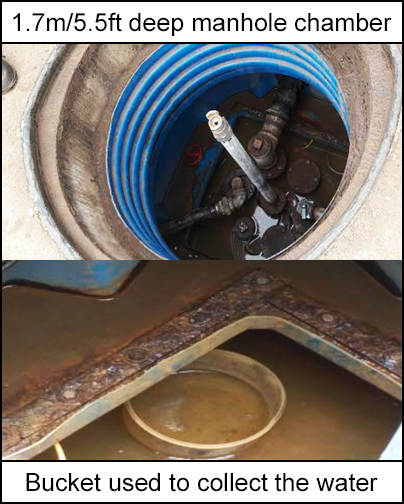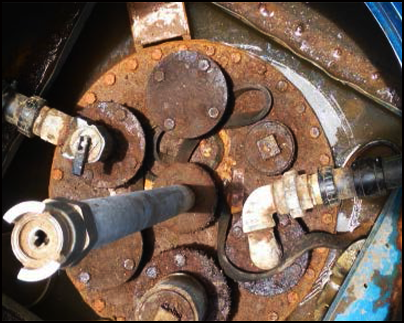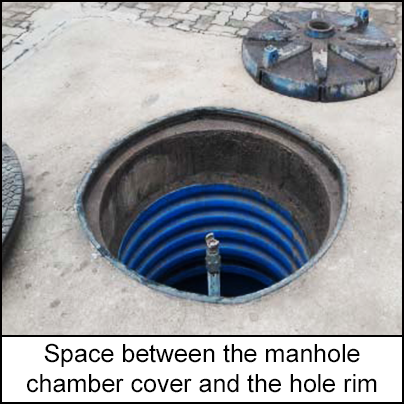-
What happened?
At a service station, rainwater had entered a gasoline tank manhole chamber.
Two attendants were assigned to scoop the water from the 1.7m/5.5ft deep and 1.1m/3.6ft wide chamber.
After opening the cover, an attendant entered the manhole and started collecting water into a bucket.
The second attendant noticed that his colleague had lost consciousness.
After calling two more colleagues, the second attendant entered the manhole and rescued his colleague.
The injured person was treated in a hospital, given medication and 3 days rest by his supervisor.

-
Why did it happen?
Rubber seal had fallen off, allowing water to seep into the manhole chamber.
Attendant lost consciousness due to low level of oxygen (13%), presence of gasoline vapours and/or carbon monoxide in the chamber.
Explosimeter/gas monitor was not used before work started.
Attendants were not wearing protective equipment.
No prevention plan or work permit was prepared.
Inadequate technical inspection and maintenance. Vapours likely entered the chamber due to:
- loss of efficiency of the closing flap on the dipping hatch.
- loss of integrity of pipe connections due to rust.
The attendant wasn’t trained or officially authorised for confined space entry.
Lack of awareness that manhole chambers are considered ATEX zone 1 (heightened risk of explosions on daily operations).

-
What did they learn?
Replace the manhole chamber seal to prevent further entry of water.
Use manual pumps for transferring water out of manhole chambers without need to enter.
Always test the level of oxygen in the manhole chamber with a gas monitor/explosimeter.
Review work processes (safety/technical) for working in manhole chambers. Identify and provide mandatory protective equipment.
Ensure staff (particularly supervisors) are trained and aware of the risks of confined space entry.
Check that the gauges have a functional check-valve head and plug.
If required, improve planning for inspection and preventive maintenance to prevent vapour leaks.

-
Ask yourself or your crew
What other actions could have been taken?
How can you prevent this from happening here today?
What can we do differently to avoid the need to enter a confined space?
What should you if your colleague lost consciousness during confined space entry?
What can you do to ensure that:
- Atmospheric tests have been conducted?
- You are wearing the right protective equipment?

Add to homescreen
Content name
Select existing category:
Content name
New collection
Edit collection
What happened?
At a service station, rainwater had entered a gasoline tank manhole chamber.
Two attendants were assigned to scoop the water from the 1.7m/5.5ft deep and 1.1m/3.6ft wide chamber.
After opening the cover, an attendant entered the manhole and started collecting water into a bucket.
The second attendant noticed that his colleague had lost consciousness.
After calling two more colleagues, the second attendant entered the manhole and rescued his colleague.
The injured person was treated in a hospital, given medication and 3 days rest by his supervisor.

Why did it happen?
Rubber seal had fallen off, allowing water to seep into the manhole chamber.
Attendant lost consciousness due to low level of oxygen (13%), presence of gasoline vapours and/or carbon monoxide in the chamber.
Explosimeter/gas monitor was not used before work started.
Attendants were not wearing protective equipment.
No prevention plan or work permit was prepared.
Inadequate technical inspection and maintenance. Vapours likely entered the chamber due to:
- loss of efficiency of the closing flap on the dipping hatch.
- loss of integrity of pipe connections due to rust.
The attendant wasn’t trained or officially authorised for confined space entry.
Lack of awareness that manhole chambers are considered ATEX zone 1 (heightened risk of explosions on daily operations).

What did they learn?
Replace the manhole chamber seal to prevent further entry of water.
Use manual pumps for transferring water out of manhole chambers without need to enter.
Always test the level of oxygen in the manhole chamber with a gas monitor/explosimeter.
Review work processes (safety/technical) for working in manhole chambers. Identify and provide mandatory protective equipment.
Ensure staff (particularly supervisors) are trained and aware of the risks of confined space entry.
Check that the gauges have a functional check-valve head and plug.
If required, improve planning for inspection and preventive maintenance to prevent vapour leaks.

Ask yourself or your crew
What other actions could have been taken?
How can you prevent this from happening here today?
What can we do differently to avoid the need to enter a confined space?
What should you if your colleague lost consciousness during confined space entry?
What can you do to ensure that:
- Atmospheric tests have been conducted?
- You are wearing the right protective equipment?
Serious accidents including fatality of service station staff have occurred during intervention in the chambers of tank manholes (deeper than 1.3m/4.2ft). The accidents generally occurred while staff were conducting water draining operations following rains or during routine product gauging inside the chamber.












